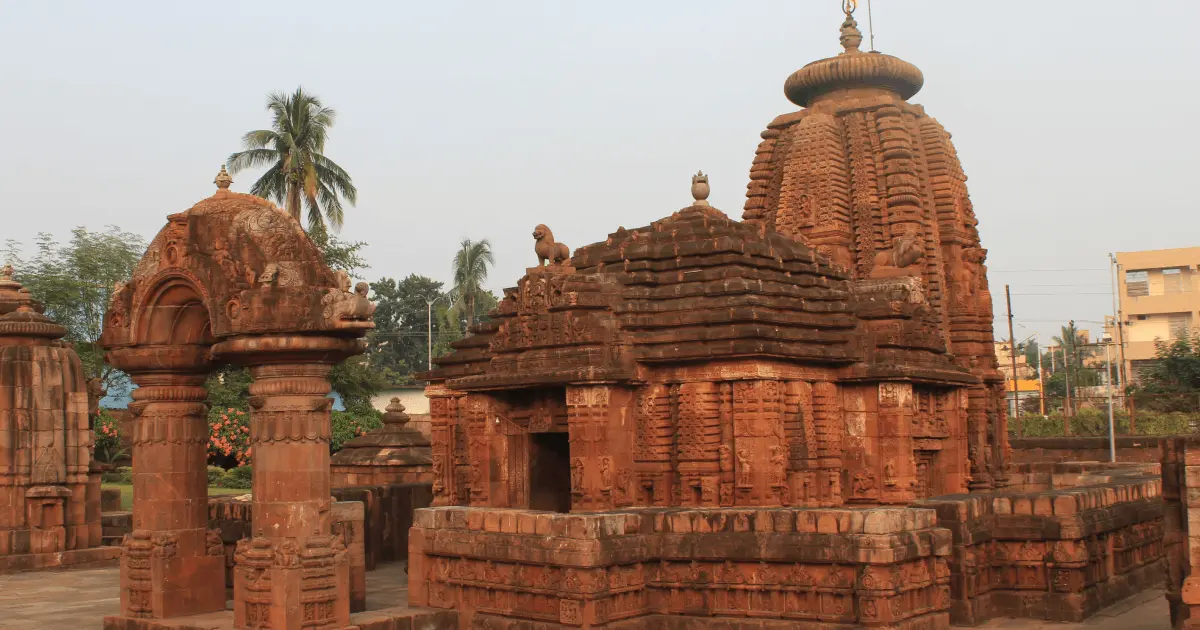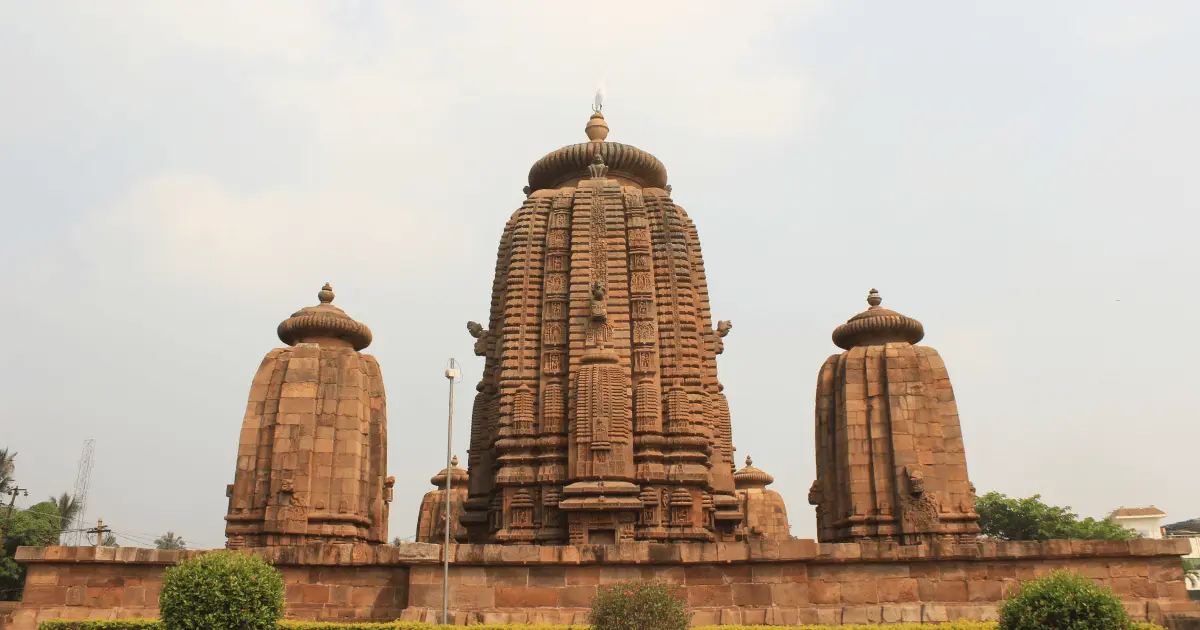Odisha Chapter
3 - 6 Feb 2023
CompletedOverview
Odisha Chapter brings to you 20 magnificent temples, dedicated to all five deities of pancāyatana worship in Bhāratavarṣa, in various different corners of Odisha, in a thrilling tour of four days.
Sūtradhāra - Your Temple Expert

Pankaj Saxena
Pankaj is an author on Hindu temples, arts, literature, history and culture. His writing explains the beauty of Sanātana Dharma through stories about traditions, communities and culture. He has a deep interest in cultural anthropology, evolutionary biology and ecology, and has visited more than 1600 Hindu temples.
Interested in this chapter?
We do not plan to repeat previously completed chapters in the near future. However, if you have a group of 15–20 interested individuals who'd love to explore this chapter, do write to us. We'd be happy to create a special on-demand Anveṣī experience just for your group.
Temples Covered

Mukteshvara
One of the most important temples of Bhubaneswar, Mukteshvara temple is dedicated to Śiva and built in the mature Kalinga nāgara style with a very beautiful and slender rekhā devala vimāna over the garbha-gṛha; a pīḍha devala jagamohana; a low sculpted boundary wall running all around; and a most exquisite free-standing toraṇa in front of its entrance, which is a unique feature in all of Kalinga architecture. This temple is small as compared to other great temples of Bhubaneswar but it holds extreme significance as it represents a mature Kalinga style and is extremely well sculpted as well as proportionate in architectural dimensions with even its jagmohana sporting all elements of ratha projections with beautiful gavākṣa meshes. Built in the 10th century it is a pride of Kalinga architecture.

Parashurameshvara
Parashurameshvara Temple is one of the oldest great temples of Kalinga architecture in Bhubaneswar. It is representative of early Kalinga style, which had a properly developed garbha-gṛha śikhara in rekhā devala style, but a jagamohana with a flat two storeyed roof. But this temple is the first one with a mandapam. The temple is dedicated to Śiva but it is also famous for many sculptures of pārṣva devatās in the deva koṣṭhas on three sides. The temple sports beautiful sculptures of Sapta Mātrikās, Kārtikeya, Rāvaṇa shaking Kaiḷāśa and other scenes from the legends of Śiva.

Kedara Gouri
This twin temple complex along with the sacred lake is a living temple which is very famous in the local community of Bhubaneswar and Odisha. The bigger temple is called the Kedareshvara temple with a rekhā devala typical Odissi śikhara over its garbha-gṛha. The temple is dedicated to Śiva. The other temple is dedicated to Śakti, or Pārvatī, called Gourī in the temple. This temple, like most Śākta temples, has a valabhi śikhara. These temples were much desecrated by Islamic invaders in the medieval ages and one can see the reconstruction by the local community. A local legend also tells that the temple was dedicated by King Lalitendu Kesari in honor of two lovers called Kedara and Gouri who both died in tragic circumstances. Hence due to their sacrifice, the temple is famous for couples who want to get married.

Siddheshvara
This temple stands in the same temple complex in which the world famous Mukteshvara temple stands. The śikhara of this temple is higher than the Mukteshvara temple and has a pancaratha plan, though with very little embellishments. This is a later temple than the Mukteshvara and is characterized by a higher śikhara, a more impressive and monumental architecture, but lesser in sculptural design and decorative motifs. The temple is dedicated to Śiva.

Bhaskareshvara
This temple is one of the most unique of all temples in Kalinga style architecture in Bhubaneswar. It has two stories and the Śiva linga is so big it takes up both the stories. It is one of the largest Śiva lingas in Odisha. The temple structure is also very peculiar. It has no jagamohana, and only a garbha-gṛha, but the garbha-gṛha vimāna is built in the pīḍha devala style which is usually preserved for the jagamohana or the maṇdapam in the Odishan temples, but here we can see a double storey pīḍha devala śikhara rising above the garbha-gṛha. The deva kosthas outside house Durga, Chamunda and Ganapati.

Brahmeshvara
It is one of the most important panchāyatana temples of Odisha still in continuous worship. Dating from the 9th century, the main temple is dedicated to Śiva. The main vimāna is pancaratha with beautiful articulation of the vimāna elements. The śuka nāsikā sports a yali or śardūla. The subsidiary shrines have simply articulated ṣikhara. The temple sports some beautiful sculptures of Lord Agni, Yama, Ambika, Kubera and Vishnu in Ekapādamurti. The temple is surrounded by a high wall which obstructs the view from afar of its lower ramparts. Built in pink and yellow sandstone it is a beautiful temple.

Megheshvara
One of the most complete but simple representatives of Kalinga architecture, this temple is a simple but serene affair with a rekhā devala over its garbha-gṛha and a very simply articulated pyramidal (pīḍha devala) jagamohana. The entrance pillars have the typical Nāgās around them. The temple is dedicated to Śiva, as the name suggests and was created in the 12th century, when the Kalinga architectural style was already waning in some ways. The temple is surrounded by a high wall on all four sides and gives it a natural boundary. The temple has a small Nandi in front of the temple representing the peculiar Kalinga style in Nandi sculptures.

Rajarani
Rajarani temple is one of the most unique temples of Odisha and in Kalinga architectural style. While Kalinga architectural style is known mostly for its rekhā devala śikharas, which are nothing but a variant of the Latina sub-style of nāgara idiom, this temple has a very unique śikhara which is in the śekhari style, one of the most complex, beautiful and accomplished styles of nāgara architecture. The garbha-gṛha is now empty and all the deva-koṣthas on all three sides are also destroyed, but most probably it was dedicated to Śiva and belonged to the Lakuḷiśa sect. Built in the 11th century, in pink sandstone, it has some of the most beautiful sculptures of couples, madanikās and other figures in all of Kalinga architecture.

Mahavinayak
Mahavinayaka Temple at Chandikhole in Jajpur district is one of the most unique temples in all of Bharatvarsha. It is dedicated to Ganapati primarily and that is why it is called Mahavinayaka temple, but in the garbha-gṛha vigṛhas of all five deities of pancāyatana worship are found in worship. That is why the temple is never closed, for one or the other deity is worshipped always. Both tulsi and bilva are found in the garbha-gṛha because both Viṣṇu and Śiva are worshipped there. It is representative of the Agneya Koṇa of Bharatavarsha, the wonderful state of Odisha, where worship of all five deities is still alive.

Lingaraja
Lingaraja Temple, dedicated to Śiva, is one of the most resplendent temples representing Odishan architecture. It is the crowning glory of Kalinga nāgara architecture bearing all its special imprints. It was built in the 11th century during the Somavansha dynasty. The temple has a very high rekhā devala vimāna with a jagamohana, a nātamandira and a bhogamanḍapa. The temple premises has 50 other temples dedicated to other deities. Lingarja is a form of both Śiva and Viṣnu called Harihara by some accounts. The temple is built of sandstone and laterite and is the largest Hindu temple in Bhubaneswar. The temple is noted in the Ekāmra puraṇa, as the main deity, Lingaraja, was once seated under a mango tree, and it is from here that Bhubaneswar acquired the name Ekāmra kṣetra.

Ananta Basudeva
Ananta Basudeva is the most important Vaiṣnava temple in Bhubaneswar, having great importance to the Vaiṣnava community. It was created in the 13th century during the reign of Eastern Ganga dynasty. The garbha-gṛha has exquisite vigrahas of Kṛśna, Balarāma and Subhadrā, just like in Jagannatha temple, Puri. But unlike Puri, here the vigrahas are complete and built in black granite stone. Balarāma stands under a seven hooded serpent; Subhadrā holds a jewel pot and lotus in her two hands, keeping her left foot over another jewel pot, while Kṛśna holds a mace, cakra, lotus and a conch. On the outer walls of the garbha-gṛha there are many mutilated forms of Varāha avatāra and trivikrama avātara as pārshvadevatās. The temple is famous for its bhoga/ prasādam which is cooked in multiple hānḍis stacked over each other and cooked perfectly in all hāndis.

Baital Deula
Baitala Deula is one of the oldest temples of Bhubaneswar dedicated to Goddess Cāmundā. Its garbha-gṛha vimāna is built in khakhara devala style as typical of tāntṛic goddess temples of Kalinga. The garbha-gṛha vimāna has three spires on the top representing the śakti of Māhāsarasvati, Māhālakṣmi and Māhākāli respectively who are represented by the great goddess Cāmundā. The jagmohana is rectangular with a flat roof but all corners have subsidiary shrines which is a peculiar feature of this temple. The presiding deity, Cāmundā sits on a corpse flanked by a jackal and an owl and decorated with a garland of skulls. She holds a snake, bow, shield, sword, trident, thunderbolt and an arrow, and is piercing the neck of the demon. It is one of the most important tāntric temples of Odisha.

Chitrakarini
Chitrakarini Temple is architecturally one of the most important temples of Bhubaneswar. It is Panchāyatana in plan, meaning it has five temples in total. One main temple dedicated to the Goddess and four temples in four corners dedicated to the other four deities of the panchāyatana fold. The temple takes its name from one of the appellations of Goddess Sarasvati, as the word Citrakāriṇi means a ‘paintress’. However, during the medieval era, the temple was destroyed and now the presiding deity is Goddess Cāmundā and not Sarasvati. The temple was built in the 13th century during the Ganga dynasty by Narasimha Deva I, the same ruler who built the famous Konark Sun Temple. While the main temple has a rekhā devala vimāna and a jagamohana, the subsidiary temples do not have any jagamohana.

Sukasari
This is a twin temple complex which was recently excavated. The bigger and beautifully ornamented temple is called the Sari temple, and the smaller temple is called the Suka Temple. The jagamohana of the Sari temple is beautifully articulated, staggered and decorated. Both of these temples were built in the 13th century CE by the Ganga dynasty. The temple is decorated with court scenes of the Ganga dynasty and various war scenes along with beautifully carved vigṛha of goddess Pārvatī. Apart from this, there are Makareṣvara, Maitreṣvara, Brahmā, Ekamreṣvara, Gangeṣvara-Yamuneṣvara, Yameṣvara and Sisireṣvara temples around the Bimbisāra sacred pond, which is the nerve center of the temple culture of Bhubaneswar.

Chausath Yogini
Chausaṭh Yogini Temple is a Tāntric temple just outside Bhubaneswar in a quiet village, dedicated to 64 Yoginis. It is said that eight great Yoginis emerged from the cosmic soul of the great deities and formed Kāli Durgā. Some sects call the great goddess Tripura Sundari. These Yoginis are called Mātrikās. Some sects have seven and some have nine Mātrikās. Most commonly they are eight. Each Yogini in turn gives birth to eight Yoginis and thus the name of 64 Yoginis. This temple is hypaethral (open air) as Yoginis are capable of flight. The temple is circular in shape. 60 Yogini shrines surround a central sanctum, called Candi Piṭha, which hosts 4 Yoginis, 4 Bhairavas and Śiva.

Konark
Konark Sun Temple is the pinnacle of Hindu temple building in so many ways. Had its śikhara been intact today, it would have been a few feet higher than the Brihadeeswara Temple, Thanjavur and thus would be the highest of all ancient Hindu temples. Built in three types of stones, the Konark Sun Temple takes the motif of a chariot to its pinnacle as the entire temple is imagined as a ratha drawn by the horses of the Sun God. While the main vimāna has fallen, the horses and wheels of the temple are still extant and have become the symbol of Kalinga temple architecture. The temple is a marvel not just from the point of view of architecture but also in its breathtaking series of sculptures still adorning the temple.

Gangeshvari
This temple is dedicated to Vārāhi Devi, a tāntric goddess, one of the Mātrikās and consequently one of the 64 Yoginis. She is the Śakti of the Varaha avatar of Viṣnu. She is supposed to hold the universe in her womb. She has the face of a sow and the body of a woman, complexion like a dark cloud. She holds cakra, mace, plough, pestle, khaḍaga, khetaka, khaṭvanga and kapāla in her hands in various combinations of two, six, eight hands. This temple is located in a picture-perfect village untouched by modernity, amidst the rural idyll alongside a lake. The temple vimāna is khakhara devala with a pīḍha devala jagamohana. The temple jagmohana has three toraṇas on three sides with the front functioning as the entrance and the side ones as windows. The temple was built in the 13th century during the Ganga period.

Barahi Devi, Chaurasi
Another Barahi Devi temple, this one is located in the Chaurasi village. It has a khakhara devala śikhara which is typical for a tāntric temple dedicated to a goddess. The Barahi vigraha in the garbha-gṛha is one of the most beautiful vigrahas of Barahi in worship. She is seated in lalitāsana with two hands, one holding mīna (fish), and other holding a kapāla for drinking blood of the demons she has killed. The temple was built in the 10th century during the Somavanshi rule. The garbha-gṛha is rectangular in size and is pancaratha in projection. The temple depicts scenes from the Rāmāyaṇa on the jagamohana like killing of the golden deer, the abduction of Sīta, the murder of Jaṭāyu, the uprooting of seven palm trees, the killing of Vāli etc. Outer walls have Lord Sūrya and a standing Gaṇapati in the deva kosthas.

Jagannath Temple
One of the Char Dhams of Hindu dharma, this temple is dedicated to the Kṛśna avatar of Śri Viṣnu. He is accompanied by Subhadra and Balarāma in the garbha-gṛha. The vigrahas are not stone or metal but wooden and huge in size. These vigrahas are remade every 12 years and it is said that the ‘soul’ inside them is transferred in secret to the new vigrahas. Temple legend says that this is where Kṛśna appeared at the end of Dvāpara Yuga as Lord Jagannātha, near the seashore and a banyan tree as the Blue Jewel. The temple is huge and one of the largest representatives of Kalinga architecture with a very high Śikhara, and three jagamohanas (maṇdapams) in front of it.

Sakshi Gopal
This temple is dedicated to Kṛśna as Gopinātha and Rādhā. The temple is built in the traditional Kalinga nāgara style with a very high rekhā devala śikhara over the garbh-gṛha. It is preceded by a khakhara-devala jagmohan (maṇdapam). The temple legend tells of a village boy who fell in love with the daughter of the village chief who would not allow them to marry. But once on a trip, the village boy helped the father of the girl when he was sick and the father promised to marry off his daughter to him but refused upon return. The boy then requested Gopinātha to come as his witness, which he did agree to but with one condition. Gopinatha would walk behind the boy to his village but the boy could never look back. Just before reaching his village the boy could not hear the footsteps of Kṛśna anymore and looked back to cross-check and consequently Kṛśna became a stone vigraha! The temple today is located at the same place where this happened.